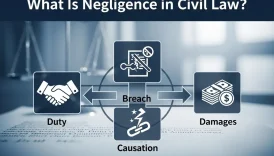What Is an Adjudication? Simple Definition & Core Meaning

Meaning of Adjudication
An adjudication is the formal legal process through which a judge, arbitrator, or authorized tribunal resolves a dispute between two or more parties. In simple terms, it means deciding a case or making a judgment. The word comes from the Latin adjudicare, meaning “to award judicially.”
In everyday language, adjudication refers to any situation where an independent authority examines evidence, hears arguments, and delivers a binding decision. It’s a cornerstone of the justice system — ensuring fairness, impartiality, and finality in conflict resolution.
Unlike informal mediation or negotiation, adjudication results in a legally enforceable outcome. This means once a matter has been adjudicated, the parties must comply with the decision unless it is overturned on appeal.
The process can occur in many settings — from civil and criminal courts to administrative tribunals or commercial arbitration panels. For example, when a court decides whether a contract was breached, or when an immigration tribunal reviews an asylum claim, both are forms of adjudication.
Ultimately, adjudication represents the point where law and evidence intersect, producing an authoritative determination of rights, obligations, or penalties.
Legal Framework & Key Characteristics For Adjudication
Adjudication operates within a carefully structured legal framework designed to ensure that disputes are decided fairly, transparently, and in accordance with established rules of procedure. While the specifics vary between civil, criminal, and administrative systems, several universal characteristics define the adjudicatory process across jurisdictions.
Key Legal Features of Adjudication
- Neutral Decision-Maker – Every adjudication is presided over by an impartial authority such as a judge, tribunal, or arbitrator who has no personal stake in the dispute’s outcome.
- Due Process of Law – Both parties must be given notice of proceedings, the right to present evidence, and the opportunity to be heard before a decision is made.
- Binding Judgment – Once rendered, an adjudicatory decision is legally binding unless overturned on appeal. It defines the parties’ rights and obligations with finality.
- Evidence-Based Evaluation – The outcome must be based on factual findings supported by admissible evidence rather than assumptions or external influence.
- Public Accountability – In most legal systems, adjudication occurs in open court or through publicly accessible records, reinforcing the principle of transparency.
Comparison: Adjudication vs. Arbitration vs. Mediation
| Aspect | Adjudication | Arbitration | Mediation |
|---|---|---|---|
| Nature of Decision | Legally binding | Binding (by agreement) | Non-binding |
| Decision-Maker | Judge or tribunal | Independent arbitrator | Neutral facilitator |
| Formality Level | Highly formal, procedural | Moderately formal | Informal |
| Appeal Rights | Usually allowed | Limited | None |
| Outcome Enforcement | Enforced by law | Enforced by contract | Based on consent |
This table highlights that adjudication differs fundamentally from alternative dispute resolution (ADR) methods. Unlike mediation or negotiation, adjudication produces a legally enforceable outcome, protecting the integrity of the judicial process.
Core Principle of Finality
The doctrine of res judicata — Latin for “a matter already judged” — prevents parties from re-litigating an issue that has been fully adjudicated. This principle maintains judicial efficiency and ensures that once a dispute has been settled through adjudication, it cannot be reopened merely because a party is dissatisfied with the outcome.
By combining due process, transparency, and finality, adjudication embodies the rule of law — the idea that all disputes should be resolved by neutral authority and not through personal power or influence.
Adjudication Process Explained Step-by-Step
To understand adjudication in its most practical form, it helps to view it as a structured sequence of procedural stages, each designed to preserve fairness and transparency. Though specific rules vary between jurisdictions, the following general steps outline how adjudication typically unfolds in both civil and administrative contexts.
1. Filing the Claim or Complaint
The process begins when a claimant submits a formal statement of grievance — often called a complaint, petition, or claim form. This document identifies the parties, the facts in dispute, and the relief sought. The opposing party (the respondent or defendant) is then served with notice and given an opportunity to respond.
2. Preliminary Review and Jurisdiction Check
Before any evidence is heard, the adjudicating body ensures it has legal authority (jurisdiction) to decide the matter. This step filters out claims that fall outside its scope or that fail to meet procedural requirements. For instance, a small claims court cannot adjudicate a multi-million-dollar corporate dispute.
3. Exchange of Evidence and Arguments
Both parties present written statements, witness testimonies, documents, or digital evidence supporting their position. In most systems, each side must disclose evidence to the other — a principle known as discovery or disclosure — ensuring no “trial by ambush.”
4. Hearing and Examination
During the hearing phase, the adjudicator listens to both parties, examines the evidence, and may question witnesses directly. This stage emphasizes due process, allowing equal opportunity to speak and defend. Proceedings are usually recorded to ensure accountability.
5. Deliberation and Decision (Judgment)
After reviewing all materials, the adjudicator deliberates privately and issues a written decision. This document includes findings of fact, interpretation of law, and the final order or award. The decision is binding unless a statutory right of appeal exists.
6. Enforcement of the Decision
Once judgment is issued, it may be enforced through various mechanisms — for example, through wage garnishment, property seizure, or court injunctions. Administrative adjudications may trigger regulatory penalties or benefits (e.g., approving or denying licenses).
7. Appeal or Judicial Review
In many systems, parties dissatisfied with an adjudicator’s ruling can seek an appeal (a rehearing by a higher authority) or judicial review (examining whether proper procedures were followed). Appeals ensure that justice remains consistent and that legal standards are correctly applied.
The adjudication process, therefore, represents a full legal cycle — from dispute initiation to final resolution — structured around transparency, fairness, and enforceability. Whether in a courtroom or before an administrative tribunal, the steps remain grounded in the same core principles of rule of law and impartial decision-making.
Types of Adjudication & Real-World Examples
Adjudication is not a single uniform process; it varies depending on the type of dispute and the institution handling it. While all forms share the same foundation — an independent authority issuing a binding decision — their procedures, timeframes, and purposes differ widely across legal, administrative, and commercial settings.
1. Judicial Adjudication (Court-Based)
This is the most familiar form, occurring in civil and criminal courts. Judicial adjudication follows a rigid structure defined by procedural rules and statutes.
- Example: In a contract breach lawsuit, the court examines evidence from both parties, applies relevant contract law, and issues a ruling ordering damages or specific performance.
- Outcome: The decision is legally enforceable and can be appealed within prescribed limits.
2. Administrative Adjudication
Administrative adjudication involves specialized agencies or tribunals resolving disputes under their regulatory jurisdiction. These bodies often operate outside the traditional court system but still follow due process principles.
- Example: An immigration tribunal determining whether an asylum applicant meets refugee status criteria.
- Outcome: The ruling can grant or deny legal status, subject to review by higher administrative or judicial bodies.
3. Commercial or Construction Adjudication
This form of adjudication focuses on business and construction disputes where rapid decisions are necessary to keep projects moving.
- Example: A contractor and subcontractor disagree over payment amounts. An independent adjudicator is appointed to resolve the issue within a fixed timeline, usually 28 days.
- Outcome: The decision is binding unless overturned by arbitration or litigation.
4. International and Investment Adjudication
Globalization has expanded adjudication beyond national borders. International courts and arbitral panels handle disputes involving states, investors, and multinational corporations.
- Example: Investor–state disputes before the International Centre for Settlement of Investment Disputes (ICSID).
- Outcome: Awards are binding on sovereign states and enforceable under international law.
Comparison of Adjudication Types
| Type | Venue / Authority | Typical Use Case | Appeal Options |
|---|---|---|---|
| Judicial | Civil or criminal court | Contract, tort, criminal offense | Statutory appeal |
| Administrative | Government tribunal or agency | Licenses, benefits, immigration | Judicial review |
| Commercial | Adjudicator or arbitrator | Construction or payment disputes | Arbitration or court |
| International | International court or panel | Treaty or investment claims | Limited (treaty-based) |
Each system reflects a different balance between speed, formality, and legal authority. For instance, administrative and commercial adjudications are faster and less formal, while judicial and international ones emphasize procedural depth and enforceability.
In real-world practice, adjudication ensures that every kind of dispute — whether between individuals, corporations, or nations — can reach a legally final and impartial resolution.
Adjudication vs. Judgment vs. Decision: Key Differences
Although the words adjudication, judgment, and decision are often used interchangeably, in legal terminology they refer to distinct but related stages of the dispute-resolution process. Understanding these nuances is crucial for lawyers, students, and professionals interpreting case outcomes or procedural documents.
1. Adjudication: The Overall Process
- Definition: Adjudication is the entire legal process through which a dispute is formally examined and resolved by an authorized body.
- Focus: It emphasizes procedure — the steps, hearings, evidence, and reasoning that lead to a conclusion.
- Scope: Broader than a judgment; it includes all procedural actions from filing to enforcement.
- Example: A labor tribunal hearing both sides of a wrongful termination case before issuing a ruling.
2. Judgment: The Final Outcome
- Definition: A judgment is the final written order or ruling delivered at the end of an adjudication.
- Focus: It declares who wins or loses and what remedies or penalties apply.
- Scope: Narrower than adjudication; it represents the conclusion, not the process.
- Example: A civil court issuing a monetary award to a plaintiff after finding the defendant liable for breach of contract.
3. Decision: The Determination Within or After Adjudication
- Definition: A decision is any formal determination made by an adjudicator at any stage — whether procedural (e.g., granting a motion) or final (e.g., dismissing a claim).
- Focus: It can occur during or after adjudication, covering both interim and conclusive rulings.
- Example: A judge granting summary judgment before trial based on undisputed facts.
Summary Table
| Term | Meaning | Stage in Process | Binding Effect |
|---|---|---|---|
| Adjudication | The process of resolving a legal dispute | Entire procedure | Leads to enforceable judgment |
| Judgment | The final written order or verdict | End of adjudication | Legally binding |
| Decision | Any ruling made by the adjudicator | During or after adjudication | Varies by context |
In essence, adjudication is the path, judgment is the destination, and decision represents the steps along the way. While these terms overlap in practice, legal precision requires recognizing how each fits into the broader framework of justice.
Modern Relevance, Benefits & Criticisms
In modern legal systems, adjudication remains the backbone of conflict resolution, serving not only courts but also regulatory agencies, private tribunals, and even online dispute resolution platforms. Its flexibility allows it to adapt to diverse contexts — from construction claims to digital commerce disputes — ensuring that justice remains accessible and enforceable in a rapidly evolving world.
Modern Relevance
- Digital Transformation of Courts – Many jurisdictions now employ virtual adjudication, where hearings, evidence submissions, and rulings occur online. This shift has expanded access to justice, especially in post-pandemic legal environments.
- Administrative Efficiency – Governments rely heavily on adjudication in licensing, immigration, and welfare matters. It helps process thousands of claims efficiently without burdening traditional courts.
- Private Sector Applications – Corporations use adjudication-like models in internal disciplinary procedures and contractual dispute clauses, promoting internal fairness and accountability.
- AI and Predictive Justice – Emerging tools analyze case histories to assist adjudicators in reaching consistent decisions, sparking debates about technology’s role in judicial reasoning.
Key Benefits
| Benefit | Explanation |
|---|---|
| Impartiality | Ensures disputes are resolved by neutral authorities under consistent rules of law. |
| Finality | Produces legally binding outcomes that prevent endless litigation. |
| Transparency | Proceedings and written judgments foster public trust and accountability. |
| Efficiency | Consolidates claims and saves resources through structured processes. |
| Scalability | Can be adapted to various legal fields — from civil to commercial to digital law. |
Criticisms and Challenges
Despite its strengths, adjudication faces increasing scrutiny in the modern era.
- Cost and Delay: Formal adjudication can be time-consuming and expensive, especially in overburdened court systems.
- Accessibility: Complex procedures and legal jargon often alienate self-represented litigants.
- Cultural and Bias Concerns: Some argue that adjudicators, being human, may unconsciously reflect social or institutional biases.
- Over-Reliance on Legal Formalism: Critics contend that strict procedural adherence sometimes overshadows substantive justice.
Reform discussions worldwide focus on balancing efficiency with fairness — streamlining adjudication without undermining the right to a fair hearing.
Conclusion & Final Evaluation of Adjudication’s Role
Adjudication remains one of the most enduring pillars of modern legal order, bridging the gap between conflict and resolution. It embodies the very essence of justice — where impartial authorities interpret law, assess evidence, and issue rulings that restore balance to social and commercial relationships.
At its heart, adjudication reflects the principle that no one should be a judge in their own cause. By entrusting dispute resolution to neutral adjudicators, society upholds fairness over self-interest and law over power. This mechanism, refined through centuries of common and civil law evolution, ensures that every conflict — from minor contractual disagreements to complex international claims — has a lawful, structured path toward resolution.
The modern landscape of adjudication continues to expand beyond courtrooms. Administrative agencies, arbitration panels, and even digital tribunals now deliver adjudicatory justice on global scales. This adaptability underscores adjudication’s resilience — its ability to evolve with technology, globalization, and social complexity while preserving its core purpose: to render just, enforceable, and transparent decisions.
In sum, adjudication is not merely a legal procedure but a societal safeguard — a dynamic process ensuring that truth, fairness, and accountability prevail even amid the most intricate disputes. Its continued evolution marks humanity’s enduring commitment to justice as both a principle and a practice.
Author Note
This article provides educational information about adjudication as a legal process within civil, administrative, and international frameworks. It is not intended as legal advice.
Readers dealing with real-world disputes should consult a licensed attorney or legal professional to understand how adjudication applies under the specific laws of their jurisdiction.
Laws governing adjudication — including procedural rights, appeal options, and enforcement mechanisms — may vary widely depending on the country and the nature of the dispute. Always verify current legislation and court rules before initiating or responding to an adjudicatory proceeding.
FAQ For Adjudication
What is the meaning of adjudication in law?
Adjudication in law refers to the formal process by which a judge, tribunal, or authorized decision-maker resolves a dispute and delivers a binding judgment. It ensures that conflicts are decided fairly and according to established legal principles.
What is the difference between adjudication and arbitration?
Adjudication is a legal process governed by statutory or judicial rules, while arbitration is a private method based on agreement between parties. Adjudication decisions can usually be appealed, but arbitral awards are often final and binding by contract.
Is adjudication the same as judgment?
Not exactly. Adjudication is the entire process of resolving a dispute, whereas a judgment is the final written order resulting from that process. Adjudication leads to a judgment; it’s not synonymous with it.
What are some examples of adjudication?
Common examples include civil lawsuits, construction payment disputes, immigration appeals, and administrative hearings. Each involves a neutral adjudicator reviewing evidence and issuing a binding decision.
What is the purpose of adjudication?
The purpose of adjudication is to provide a fair, structured, and legally enforceable method of resolving conflicts. It protects rights, enforces obligations, and ensures that justice is delivered transparently.
What happens after an adjudication decision?
After an adjudicator issues a ruling, the decision becomes enforceable under law. If a party disagrees, they may appeal or seek judicial review, depending on the jurisdiction and procedural rules.
What are the advantages of adjudication?
Adjudication offers speed, neutrality, and enforceability. It prevents multiple lawsuits over the same issue and gives all parties an impartial platform to present their case.
Can adjudication apply to digital or online disputes?
Yes. Many modern legal systems and arbitration platforms now use digital adjudication tools to handle online contract, e-commerce, or intellectual property disputes efficiently.






